物流英语chapter_5
- 格式:ppt
- 大小:175.00 KB
- 文档页数:15
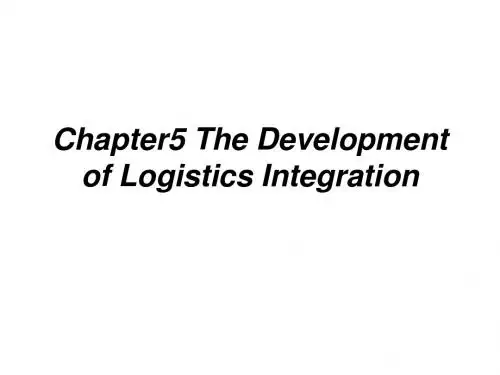
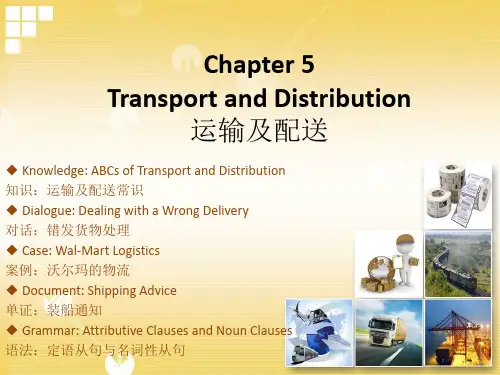

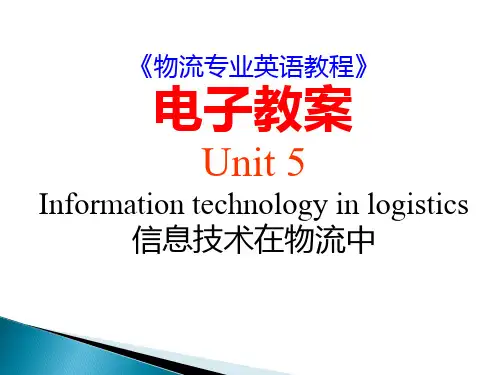
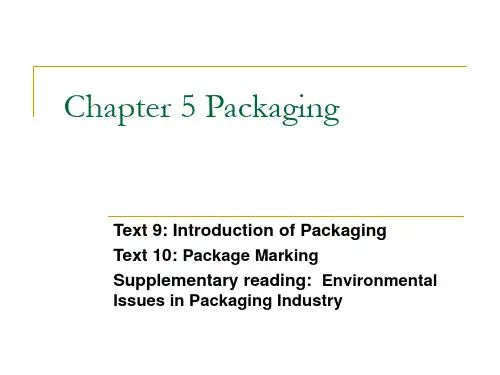


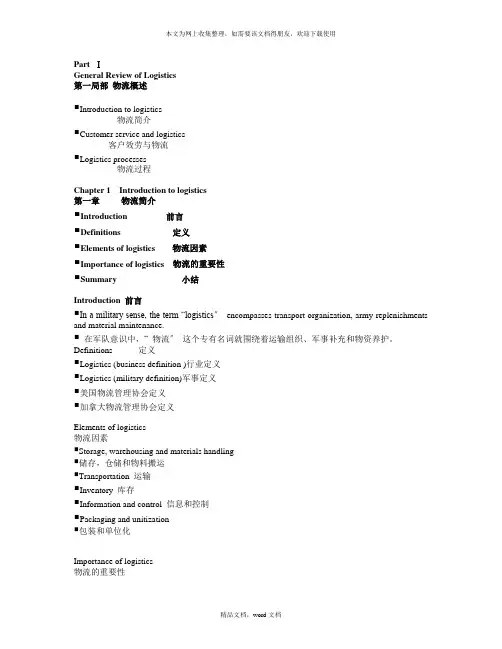
Part ⅠGeneral Review of Logistics第一局部物流概述▪Introduction to logistics物流简介▪Customer service and logistics客户效劳与物流▪Logistics processes物流过程Chapter 1 Introduction to logistics第一章物流简介▪Introduction 前言▪Definitions 定义▪Elements of logistics 物流因素▪Importance of logistics 物流的重要性▪Summary 小结Introduction 前言▪In a military sense, the term “logistics〞encompasses transport organization, army replenishments and material maintenance.▪在军队意识中,“ 物流〞这个专有名词就围绕着运输组织、军事补充和物资养护。
Definitions 定义▪Logistics (business definition )行业定义▪Logistics (military definition)军事定义▪美国物流管理协会定义▪加拿大物流管理协会定义Elements of logistics物流因素▪Storage, warehousing and materials handling▪储存,仓储和物料搬运▪Transportation 运输▪Inventory 库存▪Information and control 信息和控制▪Packaging and unitization▪包装和单位化Importance of logistics物流的重要性▪Logistics is an important activity making extensive use of the human and material resources that affect a national economy.▪物流是一项影响国民经济,充分利用人力和物料资源的重要活动。
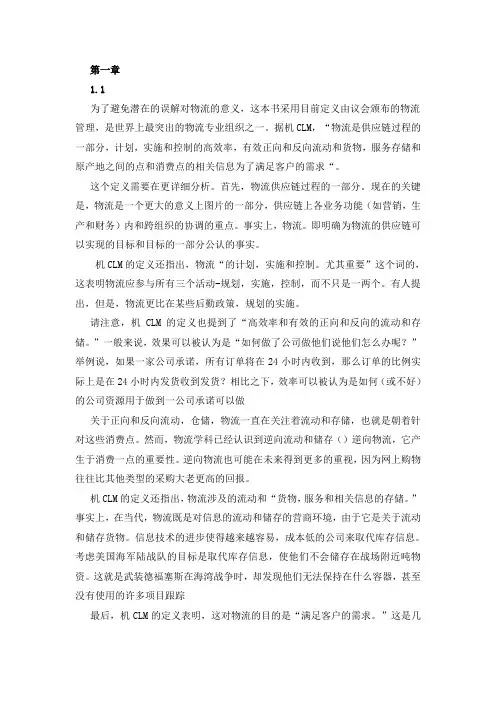
第一章1.1为了避免潜在的误解对物流的意义,这本书采用目前定义由议会颁布的物流管理,是世界上最突出的物流专业组织之一。
据机CLM,“物流是供应链过程的一部分,计划,实施和控制的高效率,有效正向和反向流动和货物,服务存储和原产地之间的点和消费点的相关信息为了满足客户的需求“。
这个定义需要在更详细分析。
首先,物流供应链过程的一部分。
现在的关键是,物流是一个更大的意义上图片的一部分,供应链上各业务功能(如营销,生产和财务)内和跨组织的协调的重点。
事实上,物流。
即明确为物流的供应链可以实现的目标和目标的一部分公认的事实。
机CLM的定义还指出,物流“的计划,实施和控制。
尤其重要”这个词的,这表明物流应参与所有三个活动-规划,实施,控制,而不只是一两个。
有人提出,但是,物流更比在某些后勤政策,规划的实施。
请注意,机CLM的定义也提到了“高效率和有效的正向和反向的流动和存储。
”一般来说,效果可以被认为是“如何做了公司做他们说他们怎么办呢?”举例说,如果一家公司承诺,所有订单将在24小时内收到,那么订单的比例实际上是在24小时内发货收到发货?相比之下,效率可以被认为是如何(或不好)的公司资源用于做到一公司承诺可以做关于正向和反向流动,仓储,物流一直在关注着流动和存储,也就是朝着针对这些消费点。
然而,物流学科已经认识到逆向流动和储存()逆向物流,它产生于消费一点的重要性。
逆向物流也可能在未来得到更多的重视,因为网上购物往往比其他类型的采购大老更高的回报。
机CLM的定义还指出,物流涉及的流动和“货物,服务和相关信息的存储。
”事实上,在当代,物流既是对信息的流动和储存的营商环境,由于它是关于流动和储存货物。
信息技术的进步使得越来越容易,成本低的公司来取代库存信息。
考虑美国海军陆战队的目标是取代库存信息,使他们不会储存在战场附近吨物资。
这就是武装德福塞斯在海湾战争时,却发现他们无法保持在什么容器,甚至没有使用的许多项目跟踪最后,机CLM的定义表明,这对物流的目的是“满足客户的需求。
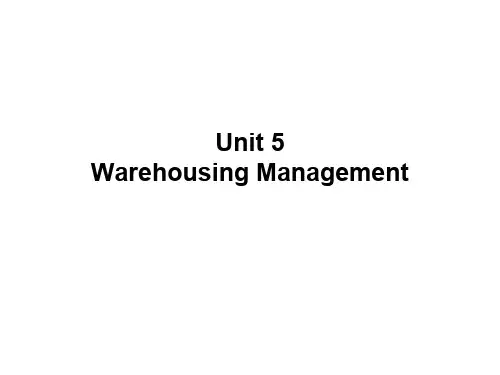
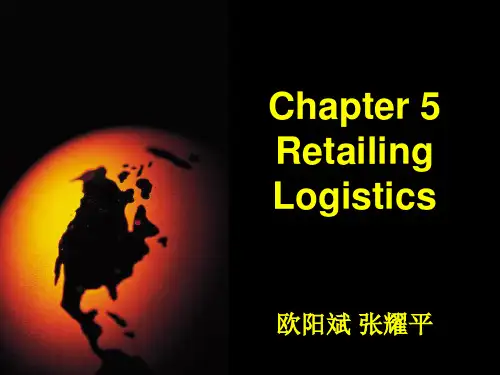
PART IIANSWERS TO END-OF-CHAPTER QUESTIONSCHAPTER 5: THE SUPPLY CHAIN MANAGEMENT CONCEPT5-1. Discuss the differences between a supply chain and supply chain management.A supply chain can be viewed as a combination of processes, functions, activities, relationships, and pathways along which products, services, information, and financial transactions move in and between enterprises from original producer to ultimate end user or customer. Supply chains are not a new concept in the sense that through the years organizations have been dependent on suppliers and organizations have served customers. Although any organization can be part of a supply chain, supply chain management requires overt management efforts within those organizations in the supply chain. Moreover, supply chain management cannot be successful unless the participating companies adopt an enterprise-to-enterprise perspective and apply the systems approach across all organizations in the supply chain.5-2. Discuss the SCOR and GSCF models of supply chain management.The SCOR model identifies six key processes—plan, source, make, deliver, return, and enable—associated with supply chain management. Each of the six processes indicates the important role of logistics in supply chain management. In the GSCF model, there are eight relevant processes—customer relationship management, customer service management, demand management, order fulfillment, manufacturing flow management, supplier relationship management, product development management, and returns management. Logistics also plays an important role in the supply chain processes in the GSCF model.5-3. Discuss how the logistics function contributes to the supply chain management processes established in the SCOR and GSCF models.With respect to the SCOR model, it can be argued that logistics has some involvement in both sourcing and making. Logistics can also be involved in delivering and returning; the definition of the deliver process specifically mentions the logistics components of order management, transportation management, and distribution management. As for the GSCF model, logistics considerations such as on-time pickup and delivery could arise within the order fulfillment process. The logistics function can contribute to customer relationship management and supplier relationship management processes in terms of outbound or inbound material being part of a product and service agreement with a key customer or supplier.5-4. What are four key enablers of supply chain management implementation?The text discussed the implications of increased customer power, establishing appropriate relationship structures, leveraging technology for enhanced visibility and communication, and the use of supply chain facilitators.5-5. What is the difference between a lean and an agile supply chain? Under what circumstances is each an appropriate supply chain approach to pursue?An agile supply chain focuses on an organization’s capability to respond to changes in demand with respect to volume and variety. Lean supply chains focus on eliminating all waste, including time, and ensuring a level schedule. An agile supply chain may be most appropriate in contexts in which customer demand is volatile and customer requirements for variety are high. In cases where customer demand is relatively stable and variety is low, establishing a lean supply chain may be a more appropriate goal.5-6. Discuss some of the ways that inventory can be reduced in the supply chain.Ways to reduce inventory in the supply chain include, but are not limited to, smaller, more frequent orders; the use of premium transportation; demand–pull, as opposed to supply–push, replenishment; and the elimination or consolidation of slower-moving products. However, prominent supply chain disruptions in the early part of the twenty-first century, such as terrorist attacks and natural disasters, have caused some supply chains to reassess their emphasis on inventory reduction.5-7. What is the difference between relational and transactional exchanges? Which is more relevant for supply chain management? Why?Relational exchanges tend to emphasize a long-term orientation whereas transactional exchanges have a short-term orientation. Unlike transactional exchanges, relational exchanges are characterized by attributes such as trust, commitment, and dependence. Supply chain management suggests that supply chains exist to improve the long-term performance of the individual companies and the supply chain as a whole. Relational exchanges also have a long-term orientation. As a result, relational exchanges are more relevant than transactional exchanges to supply chain management.5-8. Do you agree or disagree that supply chain collaboration can be classified as transactional, tactical information sharing, or strategic in nature? Why?Students could argue that supply chain collaboration is not transactional, tactical information sharing or strategic in nature, but the text argues for this classification scheme.5-9. This chapter suggests that technology has been at the center of changes taking place that affect the supply chain. Do you agree or disagree? Why?Although students can support either side of the argument, the text does argue that technology has been at the center of changes taking place that affect the supply chain. In particular, increases in computing power and the Internet have been behind much of this change.5-10. Discuss the impact of the Internet on supply chain management.The Internet can facilitate supply chain effectiveness and efficiency by providing opportunities to simultaneously improve customer service and reduce logistics costs. The Internet allows one supply chain party to have virtually instantaneous visibility to the same data that the other supply chain participants have. This visibility can ultimately result in lower inventories and improved profitability throughout the supply chain.5-11. How might regulatory and political conditions act as barriers to supply chain management?With respect to regulatory conditions, a number of today’s supply chain arrangements were illegal until the early 1980s. At a minimum, companies should be aware of regulatory considerations before pursuing supply chain arrangements. Political conditions such as war and governmental stability can also act as barriers to supply chain management. A political uncertainty such as war might cause some organizations to shy away from joining or developing supply chains that rely on companies located in warring countries. Governmental policies that either discourage interorganizational coordination or discourage doing business with certain countries would obviously have a negative impact on supply chain efficiency. As an example of government policy, the 2016 decision by the United Kingdom to exit the European Union is likely to have significant effects on European supply chains.5-12. Why is top management commitment necessary for successful supply chain management?Top management has the ability to allocate the necessary resources for supply chain endeavors and the power to structure, or restructure, corporate incentive policies to focus on achieving organizational or interorganizational (as opposed to functional) objectives.5-13. Some companies are hesitant to use frequent shopper cards because the data provided could violate the customer’s privacy. Do you agree or disagree? Why? Although either answer is acceptable, the question of data usage versus customer privacy has generated impassioned discussions by students. On the one hand, the frequent shopper cards can provide a plethora of data about the shopping habits of particular consumers, potentially allowing stores to achieve customized marketing for individual customers. At the same time, frequent shopper cards could violate customer privacy by revealing what was purchased, when it was purchased, where it was purchased, and how it was purchased.5-14. Discuss the best-of-breed and single integrator approaches.In a single integrator approach, a single vendor provides all relevant software applications (e.g., inventory management, transportation management, warehouse management, etc.). One advantage of this approach is that there should be coordination across the various applications. Alternatively, a best of breed approach chooses the best application for a particular function. This approach often requires additional software packages to coordinate the different applications—and these integrations don’t always go smoothly.5-15. Do you think corporate cultures are relevant for supply chain management? Why or why not?Either answer is acceptable. However, the text indicates that incompatible corporate cultures could present potential obstacles to effective and efficient supply chain management. For example, an organization with a participative management style might not mesh very well with an organization that has an autocratic management style. In addition, manifestations of corporate cultures, such as company rituals and company brochures, can provide important clues about the capability of potential supply chain parties to work together.5-16. Why is supply chain integration so difficult in global supply chains?Integration challenges in global supply chains include cultural, economic, technological, political, spatial, and logistical differences. Global supply chains translate into both longer and more unpredictable lead times for shipments, which increase the chances that customer demand might not be fulfilled due to a potential out-of-stock situation.5-17. Discuss the strategic and tactical considerations that can drive a company to use the services of a 3PL.The decision to use 3PL services can be driven by strategic considerations in the sense that an organization believes that one or more aspects of its supply chain(s) needs to be transformed. Alternatively, the decision to use 3PL services could be more tactical in nature. An organization might have an inefficient distribution network, an inability to control internal costs, a costly or inflexible workforce, outdated warehousing facilities, or outdated information systems.5-18. What are some reasons that third-party logistics arrangements aren’t always successful?One common cause of 3PL failure is unreasonable and unrealistic expectations, generally from the user’s perspective. Another cause of failure involves a lack of flexibility. For example, has the arrangement been structured so that unexpected occurrences can be dealt with in a timely and satisfactory manner?5-19. What is the difference between a 3PL and a 4PL/LLP?Third-party logistics refers to a situation in which one company (say, a manufacturer) allows a specialist company to provide it with one or more logistics functions (e.g., warehousing or outbound transportation). A 4PL/LLP is a company whose primary purpose is to ensure that various 3PLs are working toward the relevant supply chain goals and objectives.5-20. Discuss the three primary methods that organizations can use to integrate their supply chains.One method is vertical integration, in which one organization owns multiple participants in the supply chain. A second method involves formal contracts among various participants, such as occurs with franchising. The third method focuses on informal agreements among various organizations to pursue common goals and objectives. This option provides a great deal of flexibility, which can have both positive and negative aspects.PART IIICASE SOLUTIONSCASE 5-1: JOHNSON TOY COMPANYQuestion 1: From the standpoint of an individual concerned with accounting controls, discuss and evaluate Johnson Toy Company’s present policies for handling returned items.The controls are poor from the standpoint of accuracy of financial records because they provide poor information to management.Question 2: Answer Question 1, but from the standpoint of an individual interested in marketing.Marketing people tend to favor less stringent controls in the sense that they provide more flexibility when bargaining with retailers.Question 3: Propose a policy for handling returns that should be adopted by the Johnson Toy Company. Be certain to list circumstances under which exceptions would be allowed. Should it apply to the Jungle Jim dolls?One student’s answer is reproduced here.I.HIGH-VOLUME CUSTOMERS (defined as purchasing $75,000 ofmerchandise from Johnson’s per year)A.Functionally damaged goods may be returned to Johnson’s plant atJohnson’s expense with a full refund.B.High-volume customers will receive a straight 2% deduction off thewholesale selling price to cover defectives—whether defectives areclassified as cosmetically damaged or slow-moving items, exceptwhen unable to sell due to special circumstances (see Section III).II.LOW-VOLUME CUSTOMERSA.Functionally damaged goods may be returned to Johnson’s plant viaJohnson’s salesperson with a full refund.B.Low-volume customers will not receive an automatic deduction fordefectives. Instead, the damage or defect must be defined:1.Cosmetically damaged goods (classified as functional andsalable): a 25% discount granted upon inspection byJohnson’s salesperson.2.Slow-moving items: NO RETURNS3.Non-moving items (for reasons other than physical damage):see Section III (special circumstances).III.SPECIAL CIRCUMSTANCES When product is not resalable for reasons other than being functionally damaged or just a slow mover in the offseason, such as when the product receives bad press (as in the case ofJungle Jim and Jogger Dolls), Johnson will allow return of all such non-resalable items under the following conditions:A.Retailer must pay for the returned merchandise to reach Johnson’splant.B.Retailer’s account will be credited for the full amount of said purchase.C.Credit is to be used within 30 days of receipt of returned goods atJohnson’s plant; credit will be void after 30 days.No mention was made as to whether the returns policy should apply to the Jungle Jim dolls. The firm might try to enforce it but customers might complain that it should not be applied retroactively.Question 4: Should this policy, if adopted, be printed and distributed to all of the retailers who handle Johnson Toy Company products? Why or why not? If it should not be distributed to them, who should receive copies?Yes, retailers should know exactly what the returns policy will be. One element of a customer service policy is to let customers know in advance what the policy is.Question 5: Assume that it is decided to prepare a statement on returns to be distributed to all retailers and that it should be less than a single double-spaced page. Prepare such a statement.The answer provided for Question 3 would suffice here as well.Question 6: On the basis of the policy in your answer to Question 3, develop instructions for the Johnson Toy Company distribution and accounting departments with respect to their roles and procedures in the handling of returns.One could take the information (as developed in the answers to Questions 3 and 5) and draft a memo to be sent to both the distribution and accounting departments, telling them of the new policies and their roles in carrying out those policies. The accounting department should be told to develop additional procedures that will protect against fraud. In addition, other departments in the firm should receive some information concerning the returns because they may contain information that should interest marketing, quality control, and production scheduling.Question 7:Assume that you are Cheryl Guridi, the firm’s logistics manager. Do you think that the returns policy favored by the logistics manager would differ from what would be best for the firm? Why or why not?Yes, the returns policy favored by the logistics manager will favor a tight return policy so that her department does not have to be responsible for keeping track of returned inventories and for shipping damaged goods. The firm would probably prefer a looser return policy so that it could be used as a bargaining tool to increase sales.Question 8: Until the policy you recommend in your answer to Question 3 takes effect, how would you handle the immediate problem of retailers wanting to return unsold Jungle Jim the Jogger dolls?There are several approaches to this question. Some students have provided very specific policies. Others have said that because the policy was not in effect when the Jungle Jim dolls went out, it should not apply to their situation. This latter group favored a policy of “almost anything” that would keep retailers happy. They argued—with support from the case material—that there were a number of valued long-term relationships with retailers that should not be harmed.。